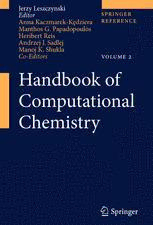Table Of ContentHandbookofComputationalChemistry
JerzyLeszczynski(Ed.)
Handbook of
Computational
Chemistry
WithFiguresandTables
123
Editor
JerzyLeszczynski
DepartmentofChemistryandBiochemistry
JacksonStateUniversity
Jackson,MS39217
USA
[email protected]
ISBN978-94-007-0710-8 e-ISBN978-94-007-0711-5
DOI10.1007/978-94-007-0711-5
ISBNBundle978-94-007-0712-2
SpringerDordrechtHeidelbergLondonNewYork
LibraryofCongressControlNumber:2011941760
©SpringerScience+BusinessMediaB.V.2012
Nopartofthisworkmaybereproduced,storedinaretrievalsystem,ortransmittedinanyformorbyanymeans,
electronic,mechanical,photocopying,microfilming,recordingorotherwise,withoutwrittenpermissionfromthe
Publisher,withtheexceptionofanymaterialsuppliedspecificallyforthepurposeofbeingenteredandexecuted
onacomputersystem,forexclusiveusebythepurchaserofthework.
Printedonacid-freepaper
SpringerispartofSpringerScience+BusinessMedia(www.springer.com)
Preface
Ithas beenanamazingexperience towitness andcomprehendtransformation of chemistry
duringthetwentiethcentury.Sinceitsancientbeginnings,chemistryhasbeenconsideredto
beanexperimentalscience.However,duringthelastyearsithasbeenadvancingthrough
noticeablecontributionsofcomputationalmethods.Thistransformationhasitsrootsinboth
theoreticalbreakthroughs(Heisenberg’sandSchrodinger’sfirstpapersonquantum
mechanics) as well as developmentof the first computer – Electronic Numerical Integrator
andComputer(ENIAC)buildinfortheUSADepartmentoftheArmy.However,ittook
abouttwentyyearsaftercreationofENIACcomputerstodelivercomputationalchemistrytech-
niques to scientific community. Such early methods being semi-empirical in nature rely on
thenumberofparametersderivedfromexperiments.Thoughsuchanapproachunitesexper-
imental chemistry origins with new theoretical approaches, in some cases it also produced
artificial computational results. Further, it also lacks reliable parameters for some elements.
Thenext,successfulchapterforcomputationalchemistrystartedintheswithapplications
of non-empirical ab initio methods. The first ab initio computer code popular among non-
theoreticians–GAUSSIAN–wasdevelopedinthesbyJohnAPople’sgroup.Itinitiated
acomputationalchemistryrevolutionthatfiredupintheswhensupercomputersbecame
accessibletothegeneralscientificcommunity.Alsoduringthisperiod,theDensityFunctional
Theoryapproachesgainedaprominentpositionamongefficientcomputationalmethods.The
vitalroleofcomputationalchemistryinmanyresearchareaswasconvincinglyacknowledgedin
whenthechemicalandphysicalcommunitycelebratedtheNobelPrizethatwasawarded
to two leading computational experts. Walter Kohn and John A. Pople were recognized by
the Nobel Committee for their contributions to the developmentof efficient computational
methodsforquantumchemistry.
Over the years, different methodsof theoretical chemistry have been successfully trans-
formedintousefultoolsthatcouldbeappliedindiverseareasofscientificandtechnological
research.Owingtothefundamentalmethodologicaldevelopmentsandcontinuedimpressive
progressincomputationaltechnologiesinthelastquarterofthetwentiethcentury,severalfast
anduser-friendlyprogramshavebeendevelopedandmadeaccessibletoawidecommunityof
scientists.Thesenearlyautomaticcomputercodesindicatehowmethodsoftheoreticalchem-
istrycouldbeappliedasbothdiagnosticandpredictiveresearchtoolswhichsupportefforts
andevenguidedirections oftraditional experimentalapproaches.Theuser-friendlyfeatures
ofcommercialcodescombinedwithefficientvisualizationmethodsmakethemaccessibleto
researcherswithpracticallyanyeducationalbackground.Generally,onlyalimitedknowledge
andalittleformalexperienceintheoreticalchemistryarerequiredtousesuchprogramsandto
obtainsomenumericaldata.Thismightcauseunexpectedoutcomes.Mostofthemethodsof
theoretical(quantum)chemistryhavealimitedrangeofapplicationsandtheirusebyaninexpe-
riencedamateurwhoperformscomputationalstudieswithoutunderstandingsuchconstraint
mayleadtoseriousproblemsandspuriousresults.Moreover,duetotheavailabilityofavariety
ofmethodsofdifferentquality,auserwithoutagoodbackgroundintheoreticalchemistrymay
feellostgiventhechoicesfromusuallyrichmenusofavailableprograms.
vi Preface
Thethreevolume“HandbookofComputationalChemistry”isprimarilyintendedasaguide
thatcanhelptonavigateamongdifferentcomputationalmethodscurrentlyinuse.Inorderto
accomplishthisgoal,wecollectedchaptersthatprovidecompactdescriptionofthebasisof
computationalchemistrytechniquesalongwithvastexamplesofapplicationsofthesemethods
invariousareas.Thehandbookisdesignedforresearcherswhoarejustbeingintroducedto
computationalmethods,aswellasforthosewhoaresearchingforthebestchoiceforsolution
tospecificproblemsinvolvingtheoreticalapproaches.
Thefirstvolumebrieflydescribesdifferentmethodsusedincomputationalchemistrywith-
out going into exhaustive details of theory. Basic assumptions common to the majority of
computational methodsbased on eitherquantum or statistical mechanics are outlined. Par-
ticularattentionispaidtothelimitsoftheirapplicability.Importantly,thisvolumealsoestab-
lishesdefinitionsofavarietyofacronymsandterminologyusedintheareaofcomputational
chemistry.
Sinceweassumedthatthereadersofthisbookareinterestedinapplicationsofcomputa-
tionalmethods,abroadrangeofthemostimportantapplicationsofcomputationalchemistry
isprovidedinthesecondsectionofthefirstvolume.Theapplicationsincludedescriptionsof
standardchemicalcalculationsformodelmoleculesundervariousconditions.TheHandbook
providesinformationonthepredictionofvariousmolecularpropertiesaswellasinvestigations
ofchemicalreactions.
Therearetwoclassesofspecies:biomoleculesandnanomaterialsthatareofavitalinterest
notonlytochemistsbutalsotophysicists,biologists,andmaterialscientists.Twovolumesare
devotedtoadescriptionofspecificcomputationalmethodsthataredesignedtoinvestigatesuch
species.Numerousexamplesofapplicationsaswellasdescriptionsofspecificresearchproblems
andtheirsolutionsforvarioustypesofbiomoleculesandnanoparticlesaregiveninthesecond
andthirdvolumesoftheHandbook.Thereviewedtopicswillattracttheattentionofallthose
whoarealreadyworkingorplanningtostartresearchinvolvingcomputationalapproaches.
Theideaofthishandbookcrystallizedafternumerousdiscussionswithadearfriendandthe
leadingPolishquantumchemistsAndrzejJ.Sadlej.Andrzejwasalsoactivelyinvolvedinselect-
ingthepotentialcontributorsandeditingthebook.Unfortunately,hepassedawaybeforethe
bookwaspublished.Thoughtheisnolongerwithus,hewillalwaysberemembered.Andrzej’s
intellectualcontributionswillcontinuetoliveonandthisHandbook,whichisdedicatedtohim,
isintendedasatributetohismemoryforfriends,colleaguesandstudentstorememberhim.
TheEditors
Editorial Board
TheoryandMethodology
AnnaKaczmarek-Ke˛dzieraandAndrzejJ.Sadlej
ApplicationsofComputationalMethodstoModelSystems
AnnaKaczmarek-Ke˛dzieraandAndrzejJ.Sadlej
SolidStatesandNanomaterials
ManthosG.PapadopoulosandHeribertReis
Biomolecules
ManojK.Shukla
Table of Contents
Preface........................................................................................................... v
EditorialBoard................................................................................................ vii
ListofContributors.......................................................................................... xiii
Volume
FromQuantumTheorytoComputationalChemistry.ABriefAccountof
Developments...........................................................................................
LucjanPiela
ThePositionoftheClampedNucleiElectronicHamiltonianinQuantum
Mechanics.................................................................................................
BrianSutcliffe ⋅R.GuyWoolley
RemarksonWaveFunctionTheoryandMethods............................................
DariuszKe˛dziera ⋅AnnaKaczmarek-Ke˛dziera
DirectionsforUseofDensityFunctionalTheory:AShortInstructionManual
forChemists..............................................................................................
HeikoJacobsen ⋅LuigiCavallo
IntroductiontoResponseTheory..................................................................
ThomasBondoPedersen
IntermolecularInteractions.........................................................................
AlstonJ.Misquitta
MolecularDynamicsSimulation:From“AbInitio”to“CoarseGrained”................
ChrisLorenz ⋅NikosL.Doltsinis
StatisticalMechanicsofForce-InducedTransitionsofBiopolymers....................
SanjayKumar
MolecularMechanics:MethodandApplications..............................................
ValeriPoltev
MolecularStructureandVibrationalSpectra..................................................
JonBaker
x TableofContents
MolecularElectric,Magnetic,andOpticalProperties.......................................
MichałJaszun´ski ⋅AntonioRizzo ⋅KennethRuud
WeakIntermolecularInteractions:ASupermolecularApproach.........................
MarkWaller ⋅StefanGrimme
ChemicalReactions:ThermochemicalCalculations..........................................
JohnD.Watts
CalculationofExcitedStates:MolecularPhotophysicsandPhotochemistryon
Display.....................................................................................................
LuisSerrano-Andre´s ⋅JuanJose´Serrano-Pe´rez
SolventEffectsinQuantumChemistry...........................................................
GeraldMonard ⋅Jean-LouisRivail
AuxiliaryDensityFunctionalTheory:FromMoleculestoNanostructures............
PatriziaCalaminici ⋅Victor-DanielDomínguez-Soria ⋅RobertoFlores-Moreno ⋅GabrielUlises
Gamboa-Martínez ⋅GeraldGeudtner ⋅AnnickGoursot ⋅DennisR.Salahub ⋅AndreasM.Ko¨ster
GuidetoProgramsforNon-relativisticQuantumChemistryCalculations............
TaoZeng ⋅MariuszKlobukowski
Volume
FunctionalNanostructuresandNanocomposites–NumericalModeling
ApproachandExperiment...........................................................................
MalgorzataMakowska-Janusik ⋅Abdel-HadiKassiba
StructuresandStabilityofFullerenes,Metallofullerenes,and
TheirDerivatives........................................................................................
AlexeyA.Popov
StructuresandElectricPropertiesofSemiconductorclusters............................
PanaghiotisKaramanis
Structures,Energetics,andSpectroscopicFingerprintsof
WaterClustersn=–...............................................................................
SoohaengYoo ⋅SotirisS.Xantheas
FundamentalStructural,Electronic,andChemicalPropertiesofCarbon
Nanostructures:Graphene,Fullerenes,CarbonNanotubes,and
TheirDerivatives........................................................................................
TandabanyC.Dinadayalane ⋅JerzyLeszczynski

